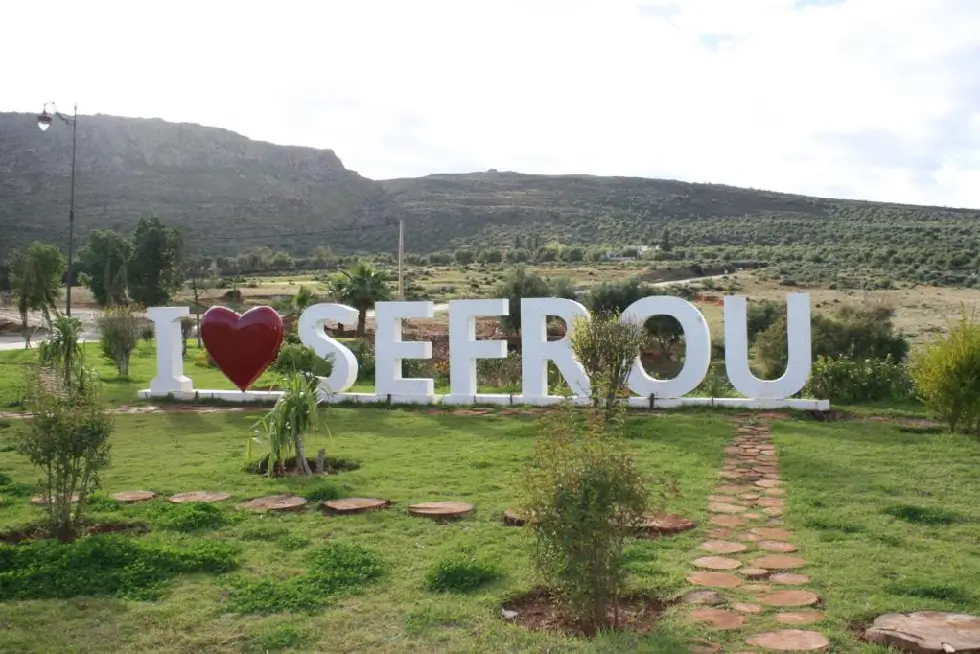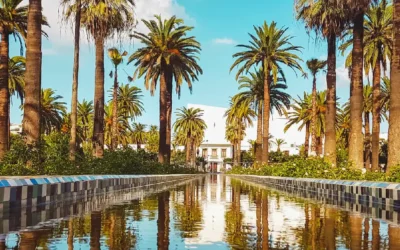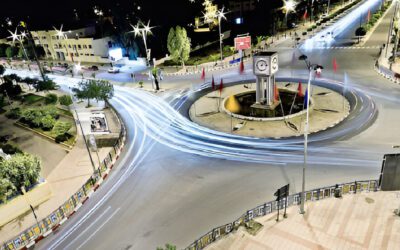Sefrou: The Town / City Of Morocco – From Berber Origins to Cherry Crowns

Table of Contents:
Introduction To Sefrou City / Town
Sefrou, referred to as both a Town and a City, is located in the Fès–Meknès region of central Morocco. It has a unique blend of cultures and traditions, influenced by Berber, Arab, and Jewish communities living harmoniously.
It is most known for its celebration of its Cherry Festival. Held since 1920. The Festival is not just about celebrating cherries; it reflects the town’s spirit of tolerance and unity.
The festival includes the inclusive “Miss Cerisette” beauty contest and features processions and celebrations that attract nationwide visitors.
Sefrou’s deep Jewish heritage dates back to 70 AD, making its Jewish community one of Morocco’s most significant.
Its cultural diversity, and natural beauty, make it a unique and enchanting Moroccan city. Its graceful ambiance and the harmonious coexistence of various faiths symbolize multicultural harmony.
Sefrou Discovery Tour
Sefrou’s blend of cultural history, religious significance, and natural beauty makes it a unique destination for travelers looking to discover and experience the diverse facets of Morocco. Some of the most popular places to visit include:
1. Ruine Synagogue du Mellah
This site is a significant religious landmark in Sefrou. It’s a testament to the town’s historical and cultural diversity.
2. Jewish Quarter “Mellah” of Sefrou
This historic area provides a glimpse into the rich heritage and history of the Jewish community in Sefrou.
Besides these specific sites, Sefrou offers a range of activities and experiences:
A. Tours & Sightseeing
There are numerous tours available, including day trips to the Middle Atlas Mountains from Fez, which offer a closer look at the region’s natural beauty and cultural richness.
B. Outdoor Activities
These activities range from nature and wildlife tours to 4WD, ATV, and off-road tours, allowing visitors to explore the scenic landscapes around Sefrou.
C. Cultural & Theme Tours
These tours provide an in-depth understanding of the local culture and history, including the Jewish legacy in Morocco.
D. Private & Custom Tours
For a more personalized experience, these tours can be tailored to your interests, whether it’s exploring historical sites or experiencing the natural beauty of the area.
E. Sporting Events and Day Trips & Excursions
These activities are ideal for those looking to add some adventure and exploration to their visit.
Sefrou Accessibility And Transportation
Transportation to and from Sefrou, particularly from Fez, is well-facilitated due to the city’s strategic location and the availability of various transportation options. Here is an in-depth look at these transportation modalities:
A. Distance and Proximity to Fez:
- Sefrou is approximately 30 kilometers south of Fez, making it conveniently close for day trips or short excursions.
- This proximity allows for a quick and easy journey, with the route offering scenic views of the Middle Atlas mountains.
B. Transportation Options:
1. Private Transportation:
- Hiring a private driver or taxi is a popular option for tourists. This mode offers flexibility, comfort, and the ability to tailor your itinerary.
- Private transport can be arranged through local travel agencies, hotels, or directly with taxi drivers. It’s advisable to agree on the fare in advance.
2. Public Transportation:
Buses
- Regular bus services connect Fez and Sefrou, offering an economical way to travel.
- Bus services are provided by various companies, and tickets can be purchased at bus stations or sometimes directly from the driver.
- The journey by bus may take longer than a private vehicle due to multiple stops.
Railway Stations
- While Sefrou itself does not have a railway station, Fez serves as a major rail hub in the region.
- Travelers can use trains to reach Fez from different parts of Morocco and then continue to Sefrou by bus or taxi.
- Moroccan trains are generally comfortable and reliable, making them a good option for longer journeys within the country.
C. Scenic Journey:
- The route to Sefrou from Fez is known for its picturesque landscapes, especially as it nears the Middle Atlas mountain range.
- Travelers often enjoy the scenic beauty of the route, which adds to the overall experience of the trip.
Modern Sefrou and its Economic Significance
1. Sefrou’s Vibrant Bazaar Economy
Sefrou boasts an economic landscape deeply influenced by its bazaar economy. This unique economic model, brilliantly analyzed by anthropologist Clifford Geertz, stands out distinctly from conventional industrial and primitive economies.
The bazaar in Sefrou is much more than a marketplace; it’s a complex social institution, blending diverse commercial practices and cultural influences, and serving as the heartbeat of the city.
2. The Crucial Role of the Jewish Community
The Jewish community has played a fundamental role in shaping Sefrou’s economy. Their involvement in local commerce, rural trade, and caravan trade has been pivotal.
More importantly, this community served as a bridge, fostering commercial relationships among various ethnic and religious groups in Sefrou.
This harmonious interplay between Jews, Amazighs, and Arabs created a unique tapestry of social and economic interdependence.
3. Sefrou’s Cherry Festival: A Cultural and Economic Highlight
The renowned Cherry Festival, also known as Miss Cerisette, is a central cultural and economic event in Sefrou. Celebrating the locally famous cherry, distinguished by its dark color and sweet flavor, the festival attracts visitors nationwide.
Featuring a beauty contest, processions, and agricultural showcases, this festival highlights Sefrou’s rich agricultural roots and its significance in the broader economy.
4. Transition of the Jewish Community
Historically, Sefrou was a hub for a significant Jewish population, many of whom were skilled artisans and traders. Their contributions were vital to the city’s prosperity, with involvement in various crafts and trades.
Over time, however, the Jewish population in Sefrou has decreased, with many relocating to other cities or countries. This shift marks a change in the cultural and economic landscape of Sefrou.
Sefrou’s History: A Melting Pot of Cultures and Religions
A. The Origin of Sefrou:
Sefrou’s rich history is marked by the coexistence of diverse communities. The city, whose name possibly comes from the Berber “Asfru,” meaning “the solution,” is a testament to cultural harmony.
B. Jewish Heritage in Sefrou
A pivotal settlement for Moroccan Jews, Sefrou has witnessed a vibrant Jewish presence for around 2,000 years. The city saw a major shift in the 8th century when many inhabitants converted to Islam under Idris I.
However, the 9th century marked a resurgence of its Jewish community, with new settlers arriving from Tafilalt and Southern Algeria.
This influx had a profound impact, shaping Sefrou’s social and economic landscape until 1967 when many descendants migrated to Israel.
C. Little Jerusalem: A Harmony of Cultures
Sefrou is affectionately known as “Little Jerusalem” due to its peaceful coexistence of Jews, Amazighs, and Arabs.
This trio of cultures lived in symbiosis, with the Amazighs focusing on agriculture, Arabs engaging in trade, and the Jewish community pioneering in banking and caravan trades.
D. Architectural Testament to History
The city’s architecture is a chronicle of its past. The old medina, surrounded by crenelated ramparts, features seven gates, towers, Jewish houses with balconies, religious lodges, mosques, bridges, and caravanserais – all narrating stories of a culturally rich and diverse society.
E. 19th Century: A Jewish Majority
Remarkably, in the 19th century, the Jewish population in Sefrou outnumbered both Arabs and Berbers. Their contributions were manifold, excelling in crafts like copper, silver, gold, leatherwork, weaving, carpentry, and trade in wood and coal.
Conclusion
As we conclude our journey through the enchanting city of Sefrou, we’re reminded of the unique tapestry that Morocco offers.
From its rich history to the vibrant cultural mix, Sefrou embodies the essence of a destination that seamlessly marries the old with the new.
Its scenic landscapes and warm hospitality leave an indelible mark on all who visit. Until next time, Sefrou remains a hidden gem in Morocco’s crown, inviting us to return and explore its myriad wonders once more.
FAQ
Why is Sefrou called “Little Jerusalem”?
Sefrou earned the nickname “Little Jerusalem” due to the harmonious coexistence of different cultures and religions, particularly the significant Jewish community that lived alongside Amazighs and Arabs.
What is the Cherry Festival in Sefrou?
The Cherry Festival, held since 1920, is a significant event in Sefrou. It celebrates not just cherries, but also the spirit of tolerance and unity in the town. It includes the Miss Cerisette beauty contest and attracts visitors from across the nation.
What is the Heritage of the Jewish people of Sefrou?
Sefrou has a deep Jewish heritage dating back to 70 AD, making it one of Morocco’s most historically significant Jewish communities.
What is the unique cultural blend of Sefrou?
Sefrou is known for its unique mix of Berber, Arab, and Jewish influences. This multicultural blend is reflected in the city’s traditions, architecture, and festivals.
What are some must-visit places in Sefrou?
Key attractions include the Ruine Synagogue du Mellah and the Jewish Quarter “Mellah.” Sefrou also offers various tours, outdoor activities, and cultural experiences.
How do you get to Sefrou, and how far is it from Fez?
Sefrou is about 30 kilometers south of Fez. It is accessible by private transportation like taxis, as well as by regular bus services. The scenic journey from Fez to Sefrou is known for its beautiful views of the Middle Atlas mountains.
What is the economic significance of Sefrou?
Sefrou’s economy is shaped by its vibrant bazaar economy, the historical role of its Jewish community in local commerce, and cultural events like the Cherry Festival.
What is the historical significance of Sefrou?
Sefrou, often referred to as “Little Jerusalem,” has a rich history marked by the coexistence of Jews, Amazighs, and Arabs. Its architecture and cultural practices reflect this diverse heritage.
How has the Jewish community in Sefrou changed over time?
Historically, Sefrou had a significant Jewish population, but over time, many have relocated, leading to a change in the city’s cultural and economic landscape.
What kind of activities does Sefrou offer for visitors?
Visitors can enjoy a range of activities including tours and sightseeing, outdoor adventures, cultural and theme tours, private and custom tours, and various sporting events and excursions.



